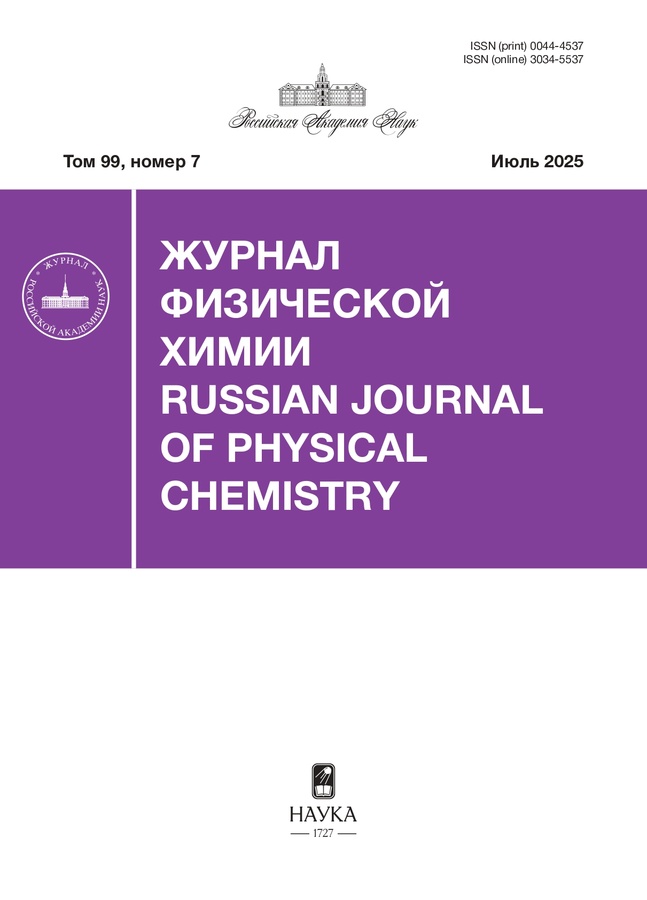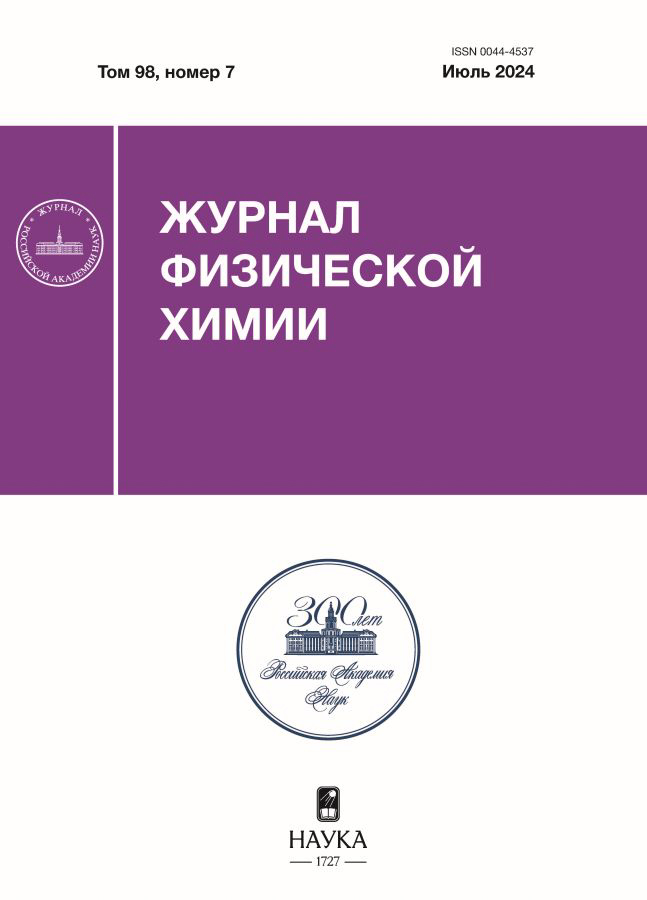Природа литиевой связи в комплексах H3N…LiHal (Hal = F, Cl, Br) по данным квантово-химических расчетов
- Авторы: Исаев А.Н.1
-
Учреждения:
- Институт органической химии им. Н. Д. Зелинского РАН
- Выпуск: Том 98, № 7 (2024)
- Страницы: 88-98
- Раздел: СТРОЕНИЕ ВЕЩЕСТВА И КВАНТОВАЯ ХИМИЯ
- Статья получена: 27.02.2025
- Статья опубликована: 15.07.2024
- URL: https://jdigitaldiagnostics.com/0044-4537/article/view/668968
- DOI: https://doi.org/10.31857/S0044453724070116
- EDN: https://elibrary.ru/PUYVRG
- ID: 668968
Цитировать
Полный текст
Аннотация
С использованием квантово-химического метода MP2/aug-cc-pVTZ выполнен сравнительный анализ свойств комплексов с литиевой и водородной связью, образованных молекулой аммиака с галогенидами лития (LiHal, А-комплексы) и галогеноводородами (ННal, Б-комплексы). Согласно данным NBO-анализа, энергия E(2) межорбитального взаимодействия мономеров растет при переходе к более “тяжелому” и менее электроотрицательному галогену с увеличением вклада p-орбитали в гибридную орбиталь атома лития в А-комплексах и гибридную орбиталь атома галогена в Б-комплексах. Расчетная величина E(2) коррелирует с удлинением ковалентных связей Li–Hal и Н–Hal при комплексообразовании. Анализ топологии электронной плотности предсказывает заметно более высокие значения электронной плотности и плотности потенциальной энергии в критической точке межмолекулярного контакта в Б-комплексах по сравнению с А-комплексами, а также бóльшее взаимопроникновение атомов, образующих межмолекулярный контакт. Более высокая термодинамическая стабильность комплексов с литиевой связью может определяться бóльшим значением положительного электростатического потенциала на атоме лития в молекулах галогенидов лития и меньшей энергией обменного отталкивания мономеров, образующих А-комплекс.
Полный текст
Об авторах
А. Н. Исаев
Институт органической химии им. Н. Д. Зелинского РАН
Автор, ответственный за переписку.
Email: isaevaln@ioc.ac.ru
Россия, 119991 Москва
Список литературы
- Gilli G., Gilli P. The nature of the hydrogen bond. Oxford: University Press, U.K. 2009.
- Peris E., Lee J.C. Jr., Rambo J., Eisenstein O., Crabtree R.H. // J. Am. Chem. Soc. 1995. V. 117. P. 3485.
- Wessel J., Lee J.C. Jr., Peris E., et al. // Angew. Chem. Int. Ed. Engl. 1995. V. 34. P. 2507.
- Metrangolo P., Resnati G. // Chem. Eur. J. 2001. V. 7. P. 2511.
- Alkorta I., Sanchez-Sanz G., Elguero J., Del Bene J.E. // J. Phys. Chem. A 2012. V. 116. P. 2300.
- Isaev A.N. // Chem. Phys. Lett. 2021. V. 763. 138195.
- Wang W., Ji B., Zhang Y. // J. Phys. Chem. A 2009. V. 113. P. 8132.
- Isaev A.N. // Russ. J. Phys. Chem. A 2023. V. 97. P. 955.
- Murray J.S., Lane P., Politzer P. // Int. J. Quantum Chem. 2007. V. 107. P. 2286.
- Del Bene J.E., Alkorta I., Sanchez-Sanz G., Elguero J. // J. Phys. Chem. A 2011. V. 115. P. 13724.
- Scheiner S. // Int. J. Quantum Chem. 2013. V. 113. P. 1609.
- Murray J.S., Lane P., Politzer P. // J. Mol. Model. 2009. V. 15. P. 723.
- Southern S.A., Bryce D.L. // J. Phys. Chem. A 2015. V. 119. P. 11891.
- Das A., Arunan E. // Phys. Chem. Chem. Phys. 2023. V. 25. P. 22583.
- Kollman P.A., Liebman J.F., Allen L.C. // J. Am. Chem. Soc. 1970. V. 92. P. 1142.
- Latajka Z., Scheiner S. // J. Chem. Phys. 1984. V. 81. P. 4014.
- Latajka Z., Ratajczak H., Morokuma K., Orville-Thomas W.J. // J. Molec. Structure 1986. V. 146. P. 263.
- Szczśniak M.M., Kurnig I.J., Scheiner S. // J. Chem. Phys. 1988. V. 89. P. 3131.
- Lipkowski P., Grabowski S.J. // Chem. Phys. Lett. 2014. V. 591. P. 113.
- Clark T., Hennemann M., Murray J.S., Politzer P. // J. Mol. Model. 2007. V. 13. P. 291.
- Politzer P., Riley K.E., Bulat F.A., Murray J.S. // Theor. Chem. 2012. V. 998. P. 2.
- Politzer P., Murray J.S., Clark T. // Phys. Chem. Chem. Phys. 2013. V. 15. P. 11178.
- Jeffrey G.A., Saenger W. Hydrogen bonding in biological structures. Berlin: Springer-Verlag. 1990.
- Kollman P. // J. Am. Chem. Soc. 1977. V. 99. P. 4875.
- Murray J.S., Lane P., Clark T., et al. // J. Mol. Model. 2012. V. 18. P. 541.
- Rosokha S.V., Vinakos M.K. // Phys. Chem. Chem. Phys. 2014. V. 16. P. 1809.
- Wolters L.P., Bickelhaupt F.M. // ChemistryOpen 2012. V. 1. P. 96.
- Riley K.E., Hobza P. // J. Chem. Theory Comput. 2008. V. 4. P. 232.
- Deepa P., Pandiyan B.V., Kolandaivel P., Hobza P. // Phys. Chem. Chem. Phys. 2014. V. 16. P. 2038.
- Frisch M.J., Trucks G.W., Schlegel H.B., et al. //Gaussian 09, Revision D.01, Gaussian, Inc., Wallingford CT, 2009.
- Moller C., Plesset M.S. // Phys. Rev. 1934. V. 46. P. 618.
- Kendall R.A., Dunning T.H. Jr., Harrison R.J. // J. Chem. Phys. 1992. V. 96. P. 6796.
- Frisch M.J., Pople J.A., Binkley J.S. // Ibid. 1984. V. 80. P. 3265.
- Reed A.E., Weinhold F., Curtiss L.A., Pochatko D.J. // Ibid. 1986. V. 84. P. 5687.
- Reed A.E., Curtiss L.A., Weinhold F. // Chem. Rev. 1988. V. 88. P. 899.
- Ditchfield R. // Mol. Phys. 1974. V. 27. P. 789.
- Wolinski K., Hilton J.F., Pulay P. // J. Am. Chem. Soc. 1990. V. 112. P. 8251.
- Lu T., Chen F. // J. Comp. Chem. 2012. V. 33. P. 580.
- Bader R.F.W. // Chem. Rev. 1991. V. 91. P. 893.
- Bader R.F.W. Atoms in Molecules, a Quantum Theory. Oxford: Clarendon Press. 1993.
- Schmidt M.W., Baldridge K.K., Boatz J.A., et al. // J. Comput. Chem. 1993. V. 14. P. 1347.
- Gordon M.S., Schmidt M.W. in: C.E. Dykstra, G. Frenking, K.S. Kim, G.E. Scuseria (Eds.), Theory and Applications of Computational Chemistry: the first forty years, Asterdam: Elsevier, 2005. P. 1167.
- McDowell S.A.C., Marcellin R.C. // J. Chem. Phys. 2010. V. 133. P. 144307.
- McDowell S.A.C., Hill J.A.S.S. // Ibid. 2011. V. 135. P. 164303.
- Cubero E., Orozko M., Luque F. // Chem. Phys. Lett. 1999. V. 310. P. 445.
- Qian W., Krimm S. // J. Phys. Chem. A 2002. V. 106. P. 6628.
- Alabugin I.V., Manoharan M., Peabody S., Weinhold F. // J. Am. Chem. Soc. 2003. V. 125. P. 5973.
- Grabowski S.J. // J. Phys. Chem. A 2011. V. 115. P. 12789.
- Bent H.A. // Chem. Rev. 1961. V. 61. P. 275.
- Li X., Zeng Y., Zhang X.-Y., et al. // J. Mol. Model. 2011. V. 17. P. 757.
- Yuan K., Liu Y., Lu L., et al. // Chin. J. Chem. 2009. V. 27. P. 697.
- Mó O., Yánez M., Elguero J. // J. Mol. Struct. (Theochem) 1994. V. 314. P. 73.
- Espinosa E., Molins E., Lecomte C. // Chem. Phys. Lett. 1998. V. 285. P. 170.
- Cremer D., Kraka E. // Angew. Chem., Int. Ed. Engl. 1984. V. 23. P. 627.
- Morokuma K., Kitaura K. in: Molecular Interactions. Wiley: New York, 1980. P. 21.
- Salai Cheettu Ammal S., Venuvanalingam P. // J. Chem. Soc., Faraday Trans. 1998. V. 94. P. 2669.
Дополнительные файлы

















